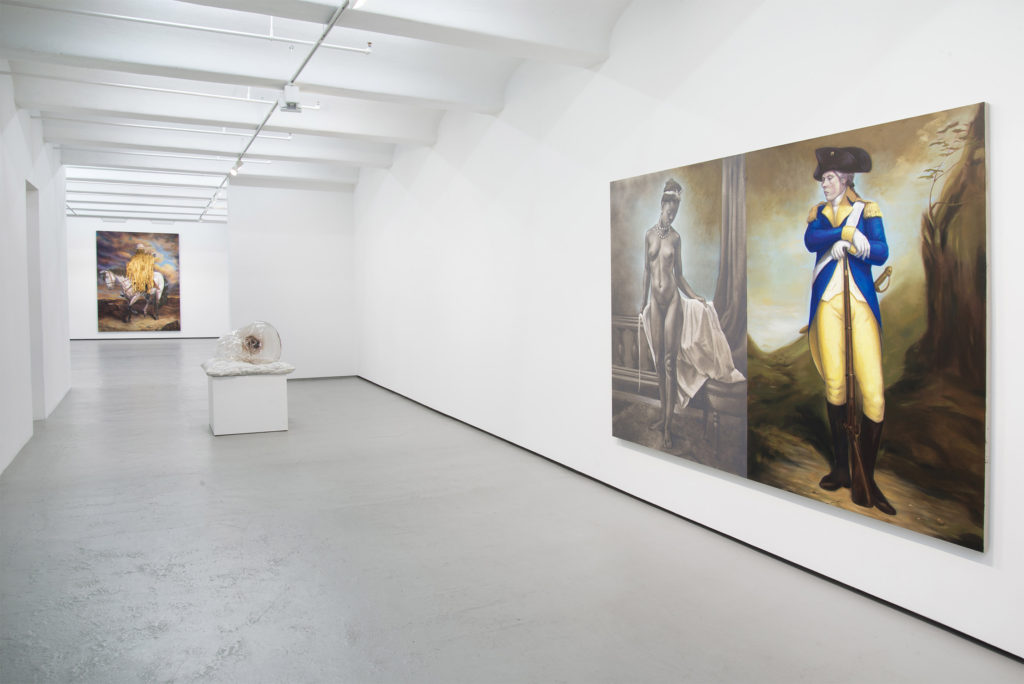
Installation view. Titus Kaphar: Shifting Skies. Jack Shainman Gallery, New York. December 16, 2016 – January 28, 2017. Courtesy of Jack Shainman Gallery, New York.
In Titus Kaphar’s remarkable second solo exhibition Shifting Skies which spans both of Jack Shainman’s galleries in Chelsea, he continues his ambitious visual exploration of the thin line between written history and fiction by dismantling monuments, heroes, and individual narratives. Not only arousing questions regarding the history of African Americans, but of an overarching system that perpetuates discrimination.
At the 24th street location, the focus is on the present- a history being written. Viewers are faced with a series of painted mugshots on the left, along with four paintings titled Forced Out of Frame (2016) on the right, depicting the same environmental landscape fading into complete darkness, the surface completely covered with tar by the last of the four paintings. Tar can be scene throughout both locations, and symbolizes a forced erasure, similar to work shown at Jack Shainman before and his Jerome Project at Studio Museum in Harlem. The use of burnt sienna, a traditional color used for underpainting, to paint mugshots refers to a large group of people affected by the criminal justice system that are nearly invisible in the media or the everyday lives of other people. The diptych of a modern and an antique play pipe that precedes the painting serves as a dark reminder that not much has changed, referring to the hosing of one- the civil rights protesters in 1963 Alabama, and two- the recent protesters during the Dakota pipeline incident.
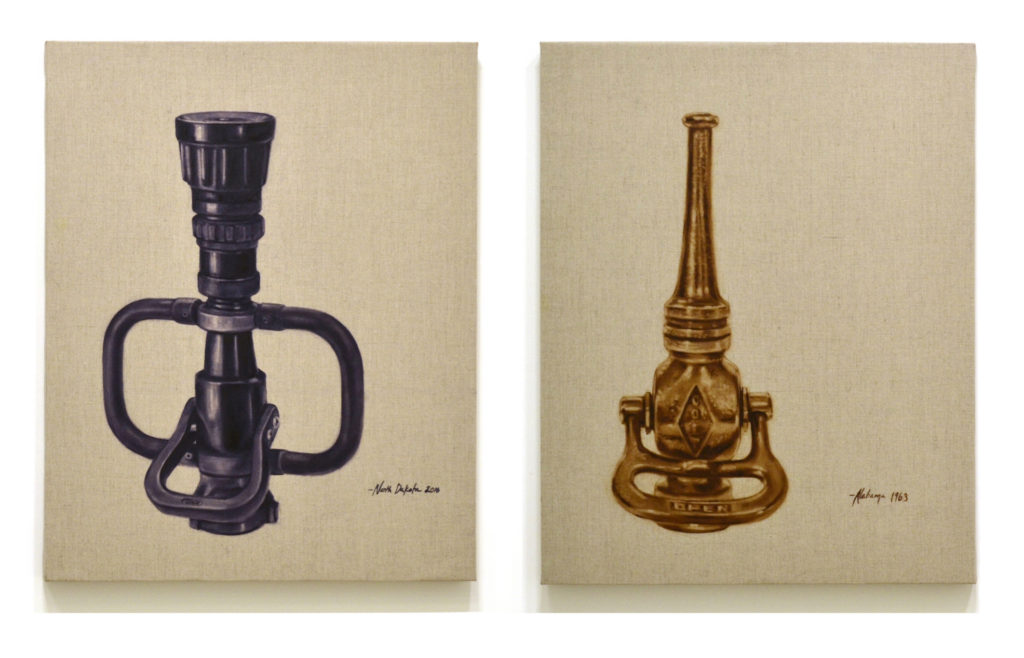
Titus Kaphar, “2016/1963,” 2016: Shifting Skies at Jack Shainman Gallery, Courtesy of Jack Shainman Gallery, 2016
In the back room of the 24th street location, Kaphar stages a narrative where Pearl, a fictional character tells a story about multiple women named Destiny she has met. In Pearl- I have known many Destinys (2016), Pearl is depicted with an unsatisfied, perhaps disappointed expression on her face, with brown stains on her chin and neck, each of the portraits have the same vibrant, cobalt blue background. In the other five portraits however, since the subjects are slightly mutilated, one can assume that this painterly gesture suggests that the narrative is being distorted as the actual event is taking place.

Installation view. Titus Kaphar: Shifting Skies. Jack Shainman Gallery, New York. December 16, 2016 – January 28, 2017. Courtesy of Jack Shainman Gallery, New York, 2016
On the other hand, much of the 20th street location contends with history that has already been written. For example in Shifting Skies (2016), the simple gesture of placing a white soldier and a black woman in a diptych, combined with the subtle voyeurism depicted by the man in the left painting sheepishly looking at the naked woman in the right is the perfect precursor to the rest of the exhibition. Not only does Kaphar dismantle such narratives, but presents his painting in a way that reflects his attitude towards history. Such mindset is demonstrated by the act of nailing shredded documents painted on canvas in order to cover half of George Washington’s face and body in Shadow of Liberty (2016), and the choice to place an ornately framed portrait of an African American boy on top of an unstretched, crumpled painting in Twisted Frames (2016). Such acts demonstrates not only resentment towards the authors of such misleading history, but also sorrow for those who were, and are continually being left out from the narrative of history.
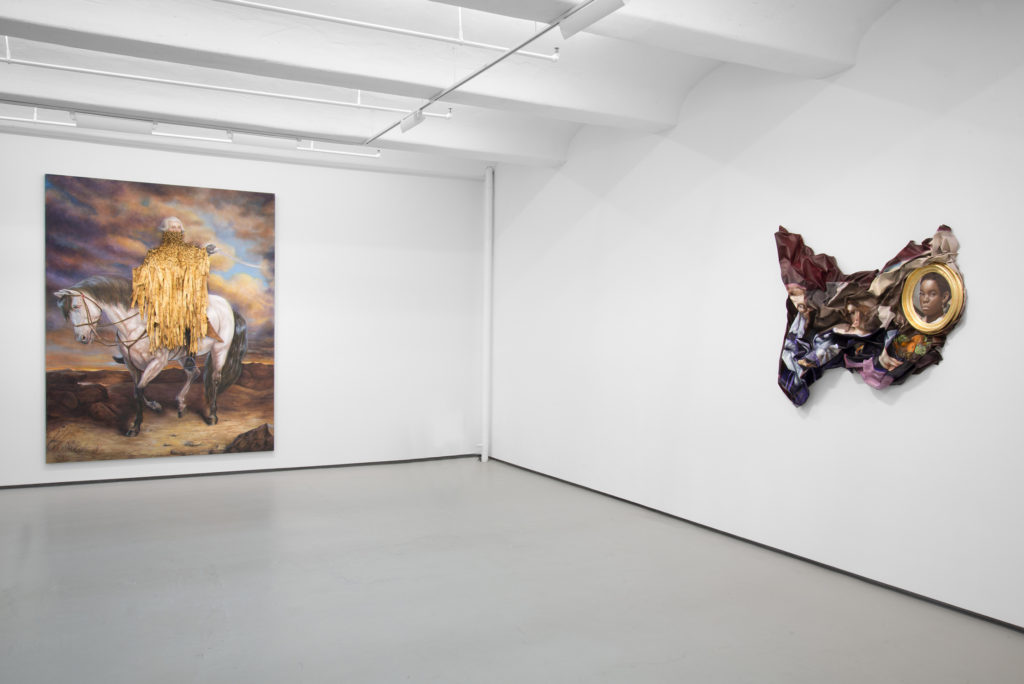
Installation view. Left: “Shadows of Liberty” (2016) Right: “Twisted Tropes” (2016) Titus Kaphar: Shifting Skies. Jack Shainman Gallery, New York. December 16, 2016 – January 28, 2017. Courtesy of Jack Shainman Gallery, New York, 2016
The most striking element of the show, both conceptually and aesthetically, lies in the introduction of glass into Kaphar’s practice working with a fabrication team at Urbanglass Studios. In A Pillow for Fragile Fictions, (2016) in which a blown glass bust of George Washington’s head s placed sideways on a marble base shaped like a pillow. The interior of the sculpture contains with molasses, rum, lime, and tamarind, all crucial items to the economy during the Colonial era in the 18th century. By thoughtfully juxtaposing these items together, Kaphar points to the decadence formulated by slave labor. In Free Trade (2016), behind the initial heavy hitting gesture, a much subtler statement towards history can be seen in this large sculpture where a monument of a figure on their horse was excavated from a block of wood, is shown along with 13 glass components- seven of them attached to the monument with thin wires, and six of them installed on the floor.
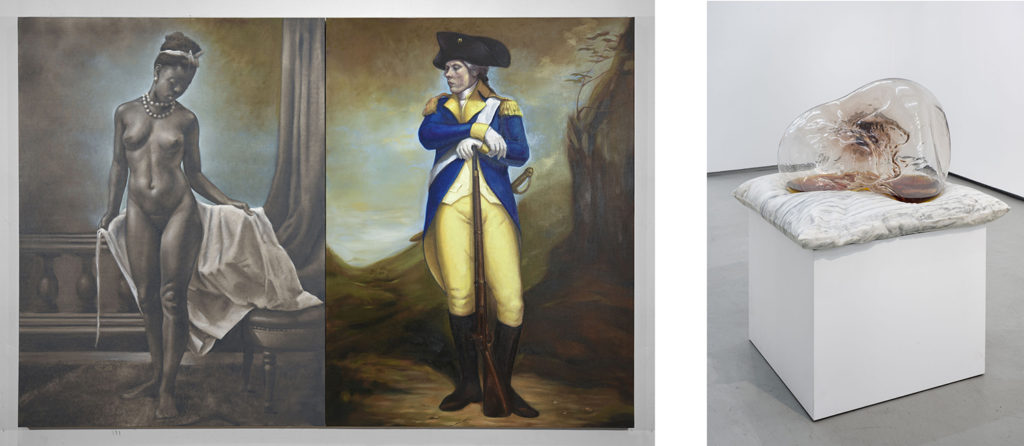
Titus Kaphar, Left: “Shifting Skies” (2016) Left: “A Pillow for Fragile Fictions” (2016) Shifting Skies, Jack Shainman Gallery, New York. December 16, 2016 – January 28, 2017. Courtesy of Jack Shainman Gallery, New York, 2016
In order to see the gesture Kaphar is making, the viewer must understand the process of fabrication behind this sculpture- specifically how the glass forms are produced. Upon closer inspection, one can see that the wooden sculpture itself is made of 13 different pieces, which are then pieced together with a steel frame. The form on the wooden sculpture is fabricated with a CNC machine, leaving the excavation of the monument. Each of these 13 pieces becomes a separate mold for the glass to be blown into, charring the molds during the process. The final product are the glass forms that are partly presented on the floor, and partly attached to the sculpture. The aforementioned subtlety is demonstrated by Kaphar’s choice to present not only the glass pieces, but the original wooden mold, thus showing not only a final product, but revealing the process behind it. He equates the unseen process of the CNC wooden molds to forced slave labor and the final product of glass to the version of written history that he continually contends with in his artworks. In a similar exploration in a photograph to the right of the sculpture titled Glass Blackened, Green Molding Mold (2016), he removes the product entirely, only showing the remains of a plaster cast of a bust of George Washington that is left burnt and molding after glass has been blown into it.
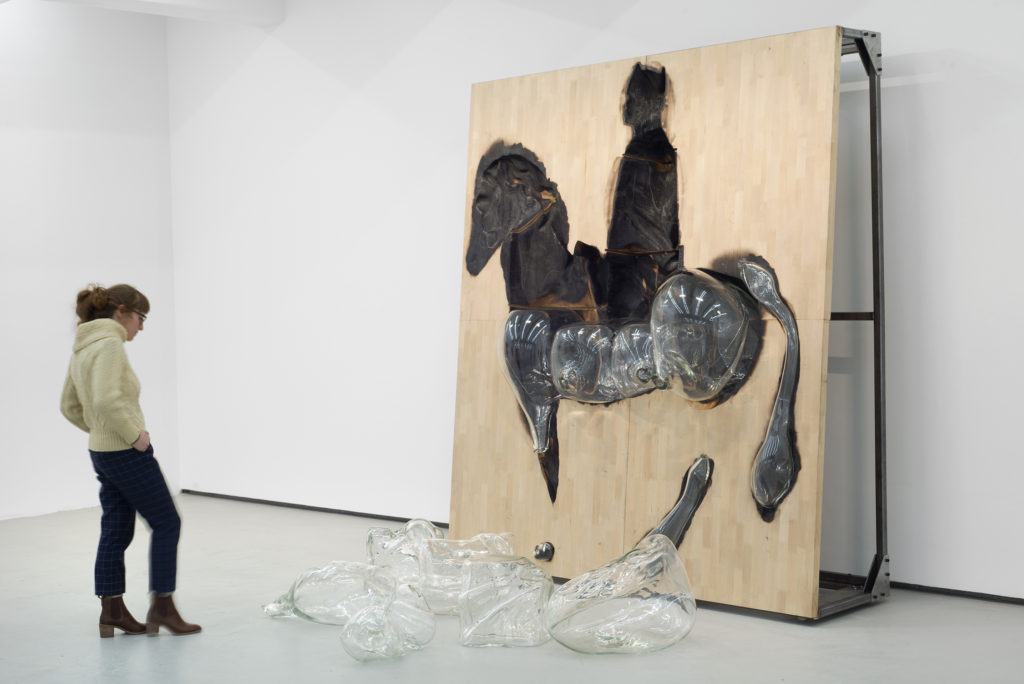
Titus Kaphar, installation view: “Free Trade,” (2016) Shifting Skies. Jack Shainman Gallery, New York. December 16, 2016 – January 28, 2017. Courtesy of Jack Shainman Gallery, New York, 2016
Forced erasure of narratives, authorship, and institutionalized discrimination are all topics of inquiry in Titus Kaphar’s determined exploration of history continues. Through sculptural materials like glass, tar, as well as the narratives portrayed in his paintings, he asks the viewers to question not only history, but the present- as history is being written- which could not be better timed in the midst of today’s national and international political climate.
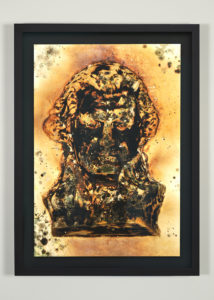
Titus Kaphar, “Glass Blackened, Green Molding Mold,” (2016)
Titus Kaphar: Shifting Skies is on view from December 16 until January 28, 2017 in both locations of Jack Shainman Gallery in Chelsea, NY.
Jongho Lee is the Editorial Assistant for Eyes Towards the Dove and a student at New York University, Steinhardt School of Education.
